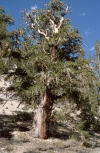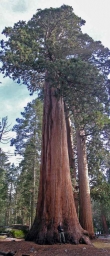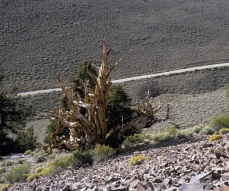Earth's elders

© Jardin botanique de Montréal (Normand Fleury)
Suppose a tree does not suffer any human or animal aggressions, and that it suffers no sickness during its life. Will this tree live eternally, or will it eventually die of old age, like all other living organisms?
Anonymous, Montreal (Quebec)
Hi!
First, we should add to your list all the environmental dangers as external death causes: fire, landslides, windstorms, frost, or even disappearance of vital nutriments from its environment. Let's focus first on the internal causes of death.
From our birth, our cells have a maximum number of divisions. Each time they divide and the new cells replace the old ones, the copy is slightly more degenerated than the original. If we photocopy a document, the result, without being an exact copy, is more than good enough. But if we photocopy the photocopy, and so on, the final result will eventually be unreadable. It is a biochemical process called methylation which is responsible of this planned degradation, the normal aging process that we call senescence.
Trees, on the other hand, do not have that limitation, because, in a way, they "switch back their meter" to zero. Each spring, they can demethyle their meristems, which contain the stem cells responsible for cell division, thus reversing the cell degradation.
However, if it is not possible to prove scientifically that trees are immortal. From a statistical point of view, they will all eventually suffer, one day, an injury or an attack that will result in their death.
But what would be the point of theoretically living old, if in reality they were to die of external causes after a too short existence? That's why trees have developed many strategies to take maximum advantage of their extreme longevity.
"The swiftness of a dart, availeth not without a timely start"
Trees like maples and oaks grow very slowly. They have a tough and very resistant wood, which can enable them to survive diseases and pest attacks. For example, there are 1500 years old Lebanon cedars. Their perfect adaptation to the growing environmental conditions and to the animals and insects that live there would have contributed to their venerable age. Just imagine, these cedars were born around the time the Occidental Roman Empire fell.

© Jacques Brisson
The giant sequoia (Sequoiadendron giganteum)
Size does matter!
The second strategy is quite simple: it's gigantism. An apple tree, a couple of meters high, clearly has more chances to die to herbivore attacks than a giant sequoia measuring more than 90 meters. In fact, sequoias can live almost 2000 years, while apple trees have a much more modest life expectancy.
The Clone wars
Science fiction fans are probably familiar with the third survival strategy: cloning. Even though the tree seems to die (its trunk, branches and leaves die-off after some years), we suddenly see new shoots growing from its stump or roots. They will grow and develop into a new tree. These sprouts are not exactly the same tree as the original, but they develop from a part of the original tree and possess the exact same genetic material.

© Leif Kullman, Professor of Physical Geography, UmeÃ¥ University
Is this tree 9550 or 600 years old?
So we say that a Norway spruce is 9550 years old, during the Stone Age. But 9550 years, that's the age of its roots. Its actual trunk is a "youngster", only 600 years old!
But it's not the most exceptional case. In Tasmania, a King's Lomatia has now produced many hundreds of clones of itself. The tree from which the clones originated was alive when the Neanderthals were still on Earth: about 43000 years ago!
Several trees that grow in environments subject to frequent fires have developed an adaptation that promotes the growth of these sprouts. They possess a lignotuber: a large underground woody protuberance full of adventitious buds and nutrients. The lignotuber, in the ground, is protected from fire. Its adventitious buds have access to a large nutrient stock and will develop into sprouts should the tree suffer trauma. Some redwoods and eucalyptus, the cork oak and Ginkgo biloba have lignotubers.

© Jardin botanique de Montréal
This Bristlecone pine (Pinus longaeva) grows in an inhospitable environment
Born in the right place
We must also think about where trees grow. Surprisingly, some trees live longer in... adverse environments! With little water or nutrients, life is harsh, but it is equally, if not more, for pests that prey on these trees, and are thus rarely or never present in these environments.
For example, Quebec's oldest tree, a 913 year old cedar, grows on a small island. Its location protects it from certain insect pests and forest fires. Similarly for "Methuselah", a Bristlecone pine in California that grows high in the mountains. Summer there only lasts a few weeks, the majority of precipitation falls as snow and the limestone soil contains very few nutrients. Still! Methuselah is 4,900 years old. That's older than the pyramids of Egypt...
So even if we cannot say that trees are immortal, it is still correct to say that they have an unusually long life expectancy, and that they are definitely the deans of this planet.
Mathieu Lanteigne-Cauvier
Scientific Writer
Trees Inside Out
Question from the Public
- What is a tree?
- Earth's elders
- The products of photosynthesis
- Sugar maple bleeding
- Conifers and hardwoods leaves and fruit
- Leaves of trees in arid regions
- Question blitz: The Arboretum's trees
- Question blitz : tree care
- Trees through the world
Tree Tales
- Unique trees at the Botanical Garden (Part 1)
- Unique trees at the Botanical Garden (Part 2)
- Unique trees at the Botanical Garden (Part 3)
Do you want to send us a question or share a story? Please write!




